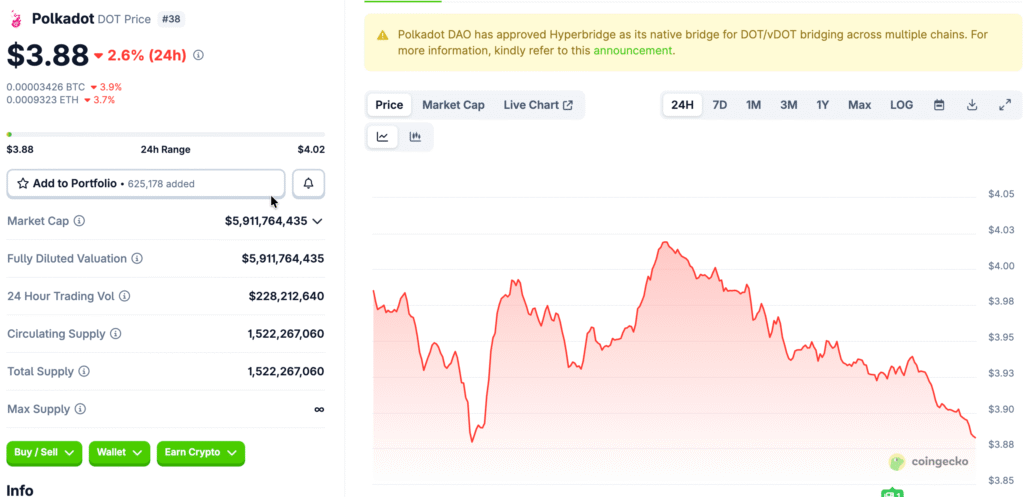Polkadot Community Shows Strong Early Support for pUSD Launch
Members of the Polkadot community are very excited about a new plan to create a native algorithmic stablecoin that is fully backed by DOT tokens. Early voting results show that most people support the initiative, with more than three-quarters of participants voting in favor during the first governance phase.
The proposal’s goal is to make Polkadot’s financial infrastructure stronger by making it less reliant on centralized stablecoins like USDT and USDC. More than $5.6 million worth of DOT has already been put toward votes, which shows that people are very interested in the ecosystem and believe in the stablecoin’s potential benefits.

Proposal Introduced by Acala Co-Founder Bryan Chen Gains Traction
Bryan Chen, co-founder and chief technology officer of Acala Network, officially presented the plan to the Polkadot community on Sunday. His plan includes creating pUSD, an algorithmic stablecoin that only uses DOT tokens as collateral and is built on Acala’s Honzon stablecoin protocol infrastructure.
This idea fits with Polkadot’s larger goal of making its ecosystem more decentralized and economically stable. Polkadot can improve liquidity, security, and independence from centralized assets by adding a native stablecoin. This will help it stay competitive in the blockchain space.
Honzon Protocol Powers the Proposed Algorithmic Stablecoin Design
The Honzon decentralized stablecoin and collateralized debt position protocol will be used to back the pUSD stablecoin. It will only work on the Acala network. This framework lets you manage collateral safely and openly while keeping the peg stable through algorithmic methods instead of centralized custodial systems.
Honzon uses on-chain digital assets and smart contracts to make sure that collateral backing is always verifiable and can’t be censored. This design gives Polkadot an independent monetary system that can support internal economic activity without needing help from outside sources.
Recommended Article: Polkadot Pushes pUSD Stablecoin Amid aUSD Collapse Concerns
Optional Savings Module Adds Additional Utility for pUSD Holders
The proposed design has an optional savings module that lets pUSD holders lock their tokens and earn interest from stability fees. This feature encourages people to stay involved in the long term and helps keep the peg stable by keeping stablecoins in the ecosystem instead of just trading them for profit.
These kinds of systems make money more stable by balancing supply and demand while giving holders chances to earn interest. Encouraging people to save can make the stablecoin more appealing to people who want to use it and make money passively in decentralized financial settings.
Algorithmic Stablecoins Offer Decentralization Advantages Despite Risks
Algorithmic stablecoins keep their pegs through programmed economic incentives instead of centralized reserves. This makes them more decentralized. These designs allow people to access things without permission, limit the number of places where regulators can control things, and support ecosystems that can’t be censored. This is in line with Polkadot’s principles of decentralized governance.
But this group is still very controversial after the terrible collapse of TerraUSD, which shook people’s faith around the world. Proponents contend that enhanced design frameworks and resilient collateralization strategies can rectify past shortcomings, facilitating the emergence of sustainable algorithmic stablecoin models that foster decentralized financial growth.
Historical Lessons Shape Modern Algorithmic Stablecoin Development
The failure of TerraUSD showed how algorithmic stabilization mechanisms can fail when the market is under a lot of stress. Modern proposals focus on overcollateralization, a wider range of incentives, and stronger governance structures to fix these problems from the past.
Polkadot’s approach uses what it learned from making pUSD an overcollateralized debt token. This strategy cuts down on systemic risk a lot compared to previous models that didn’t work, making the system more stable during times of market volatility while still keeping the benefits of decentralized algorithmic stablecoins.
Polkadot Ecosystem Stands To Gain From Native Stablecoin Integration
Launching pUSD could help Polkadot in many ways, such as making liquidity more efficient, making it less dependent on outside assets, and making the ecosystem more secure. A stablecoin backed by DOT would make it easier for transactions, lending, and decentralized finance apps to work together on the network.
This project also shows that Polkadot is dedicated to being innovative and self-sufficient. Polkadot is a forward-thinking blockchain ecosystem that values autonomy, resilience, and long-term growth. It does this by using a decentralized currency that is controlled by the community.


















